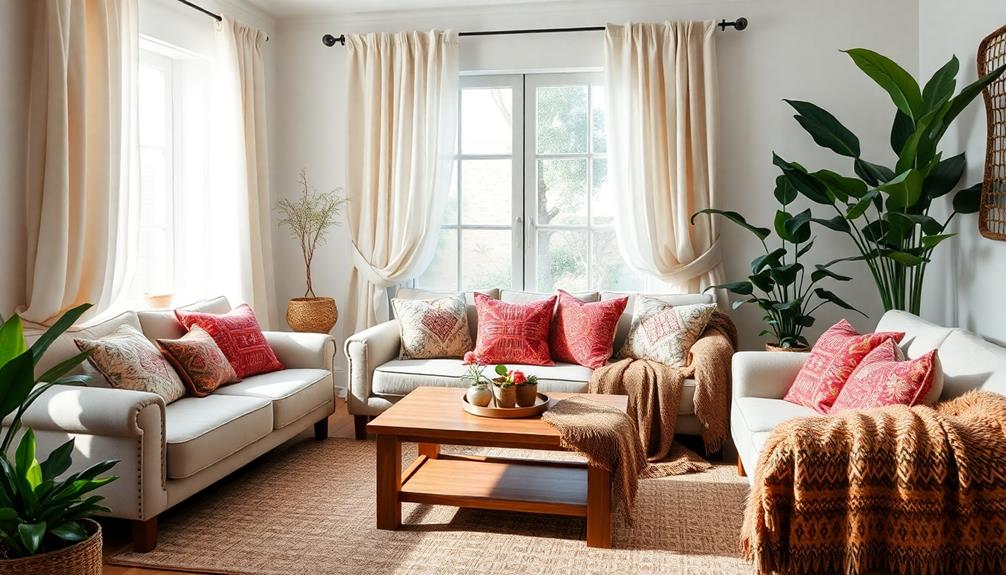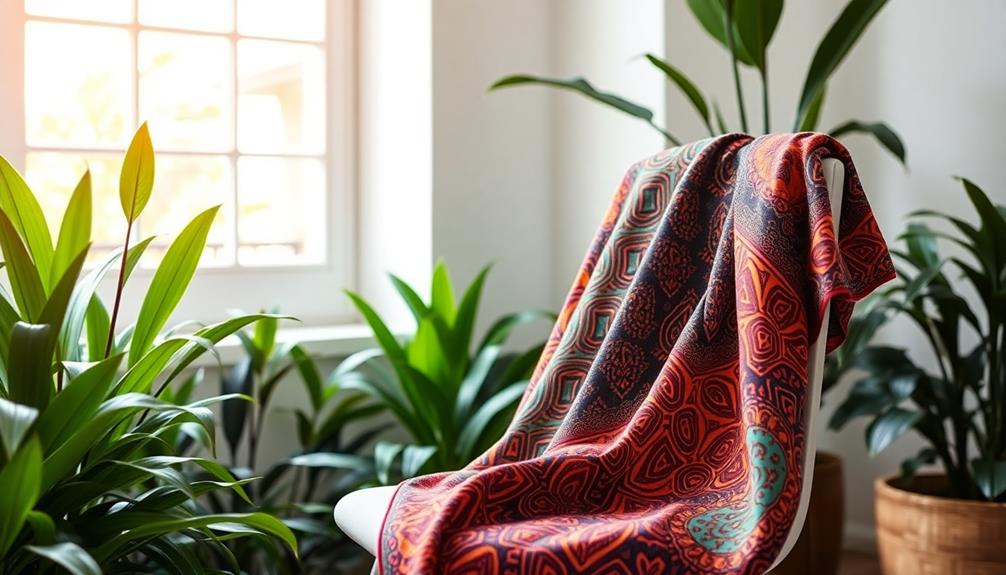Certain foods are considered aphrodisiacs in various cultures because of their rich symbolism and historical ties to love and desire. For example, oysters symbolize femininity, while strawberries evoke romance. Nutritional components play a role too; foods like dark chocolate and chili peppers can boost mood and blood flow. Different cultures celebrate unique ingredients, like Brazil's coconut or honey in Ethiopia, connecting them to intimate experiences. The psychology behind these beliefs enhances their allure, making them more effective. If you're intrigued, there's a wealth of fascinating details waiting for you to uncover.
Key Takeaways
- Aphrodisiacs are believed to enhance sexual desire and performance, rooted in cultural traditions and historical beliefs.
- Foods like oysters and chocolate symbolize romance and fertility, influencing their status as aphrodisiacs in various cultures.
- Scientific validation for aphrodisiac claims is limited, with psychological factors and the placebo effect playing significant roles.
- Cultural narratives, memories, and social contexts shape perceptions of specific foods as aphrodisiacs across different regions.
- Nutritional components in foods, such as zinc in oysters and citrulline in watermelon, may contribute to their aphrodisiac qualities.
Definition of Aphrodisiacs
Aphrodisiacs are fascinating substances—foods, drinks, or other items—believed to boost sexual desire and enhance performance. The term derives from Aphrodite, the Greek goddess of love and beauty.
Historical records show that various cultures have long utilized different foods as aphrodisiacs, often rooted in folklore and cultural beliefs rather than scientific validation. For instance, certain dishes like Red-Braised Pork Belly are celebrated not just for their flavors but also for their association with family gatherings and romantic dinners.
You might find that common examples like oysters, chocolate, and strawberries are frequently associated with sensuality and romance.
Interestingly, the effectiveness of these aphrodisiacs often hinges on psychological factors. If you believe in their potency, that mindset can greatly enhance your sexual experiences. This highlights the powerful role of perception in sexual arousal.
However, despite the widespread belief in these foods' effects, scientific validation remains limited. Many claims about aphrodisiacs lack robust empirical support or reproducible results, leaving you to wonder if it's all in your head.
Cultural Significance of Foods
Foods play a significant role in various cultures, often intertwined with beliefs and traditions surrounding love and desire. Many societies attribute aphrodisiac qualities to certain foods, drawing connections between their shapes or colors and romantic sentiments.
For instance, oysters are linked to femininity, while strawberries, with their heart shape, symbolize romance. In Brazilian culture, ingredients like coconut are often celebrated for their sweet and tropical flavor, which can evoke feelings of warmth and affection.
Pomegranate stands out for its cultural significance, representing fertility and abundance. Its numerous seeds link it to Aphrodite, the goddess of love, in Greek mythology. Similarly, asparagus has a rich historical use as an aphrodisiac, especially highlighted in ancient texts that celebrated its ability to enhance libido, particularly among brides in France.
Honey, revered for its potential to boost sexual vigor, has deep roots in history. It's even where the term "honeymoon" originates. Ancient physician Hippocrates recommended honey for its aphrodisiac properties, showcasing its long-standing place in romantic traditions.
Common Foods Considered Aphrodisiacs
When it comes to enhancing desire, certain ingredients have earned their reputation as go-to aphrodisiacs throughout history. Oysters top the list, packed with zinc, which is known to boost testosterone levels and enhance sexual desire.
Dark chocolate follows closely, containing phenylethylamine and serotonin, both of which elevate mood and foster feelings of attraction—definitely a treat to share with someone special.
Interestingly, spices used in various cuisines, such as those found in Mushroom Masala, can also play a role in enhancing flavors and perhaps even desire. Chili peppers are another exciting option. Their active component, capsaicin, increases blood flow and stimulates nerve endings, potentially heightening sexual arousal and excitement.
If you're looking for something invigorating, consider watermelon. It's rich in citrulline, an amino acid that improves blood flow and can mimic the effects of certain erectile dysfunction medications.
Lastly, strawberries are often associated with love. Their high antioxidant and vitamin C content may contribute to overall sexual health and energy.
Historical Perspectives on Aphrodisiacs
Throughout history, various cultures have linked certain ingredients to enhanced sexual desire and performance. The term "aphrodisiac" itself comes from Aphrodite, the Greek goddess of love and beauty, showcasing the deep-rooted connection between food and sexual desire.
Historical texts from ancient civilizations, like the Egyptians and Greeks, reveal the use of bizarre substances, such as mandrake root and crocodile heart, believed to boost virility. In Indonesia, traditional desserts like Kue Putu are often enjoyed during festive occasions, symbolizing the joy and connection between sharing food and intimacy.
In ancient Rome, some even thought that consuming young men's semen could transfer virility. Meanwhile, the Chinese often turned to animal sexual organs as potent aphrodisiacs. Foods shaped like genitalia, such as figs and oysters, frequently sparked erotic thoughts across various cultures, further cementing their status as aphrodisiacs.
Chocolate, revered as the "food of the gods" by the Aztecs, underscores the cultural significance of certain foods in relation to sexual attraction.
These historical perspectives not only illustrate the varied beliefs surrounding aphrodisiacs but also highlight how deeply intertwined food and sexuality are in human culture. As you explore these connections, you can appreciate the rich tapestry of traditions that influence our understanding of desire and attraction today.
Scientific Insights and Research
Delving into the domain of scientific research reveals intriguing insights into how certain foods can impact sexual desire and performance. For example, traditional dishes from various cultures, like Muamba De Galinha, highlight the role of flavorful ingredients in enhancing not just taste but potentially also intimacy.
Scientific studies suggest that certain foods, like oysters, may enhance sexual arousal due to their high zinc content, vital for testosterone production and sperm development. Research also points to dark chocolate, which can influence arousal through the release of phenylethylamine, although evidence supporting substantial aphrodisiac qualities remains inconclusive.
Chili peppers, containing capsaicin, may improve blood flow and stimulate nerve endings, potentially heightening arousal; however, human studies on this are limited. Watermelon stands out for its citrulline content, which can help improve blood flow and mimic the effects of erectile dysfunction medications, though how much you consume can vary widely.
While these findings are compelling, it's important to reflect on the role of psychological factors in how you perceive these aphrodisiac qualities. The placebo effect can notably enhance your sexual experiences, as your belief in the effectiveness of certain foods can amplify their impact.
Therefore, understanding the science behind these foods can enrich your approach to enhancing intimacy.
Placebo Effect and Psychological Factors
Harnessing the power of belief, the placebo effect plays a crucial role in how you perceive the effectiveness of aphrodisiac foods. When you consume a food you believe to be an aphrodisiac, your mindset and expectations can greatly enhance your sexual desire and arousal.
For instance, nutritious blends like nettle and potato soup can evoke feelings of warmth and comfort, which may enhance your intimate connections. The mere thought that a food might boost your intimate experiences activates neural pathways related to pleasure, amplifying your physical responses.
Psychological factors, such as cultural narratives and social contexts, influence your perception of these foods. You might find that certain items trigger memories or associations linked to past pleasurable experiences, thanks to behavioral conditioning. This connection can lead you to expect heightened arousal when consuming these foods, further reinforcing their perceived efficacy.
Moreover, open-label placebo studies reveal that simply knowing you're taking something that could enhance your sexual experience can lead to positive outcomes, regardless of the actual effectiveness of the substance.
Nutritional Components and Benefits
The allure of aphrodisiac foods lies in their rich nutritional components, which can enhance not only sexual desire but also overall health. Foods like oysters, dark chocolate, chili peppers, watermelon, and strawberries offer unique benefits that contribute to your romantic experiences.
For instance, traditional Mexican dishes, such as Chilaquiles, aren't only flavorful but also provide a comforting start to any special occasion.
- Oysters: High in zinc, essential for testosterone production and reproductive health.
- Dark chocolate: Contains phenylethylamine, linked to mood enhancement and attraction.
- Chili peppers: Rich in capsaicin, which boosts blood flow and stimulates endorphin release.
- Watermelon: Packed with citrulline, improving blood flow and acting similarly to erectile dysfunction medications.
Strawberries, on the other hand, are loaded with antioxidants and vitamin C, supporting overall health while improving blood circulation.
Each of these ingredients works together to create an environment conducive to passion and intimacy. By incorporating these foods into your meals, you not only indulge in their delicious flavors but also harness their aphrodisiac qualities.
Risks and Health Considerations
Considering the appeal of aphrodisiac foods, it's important to recognize the potential risks and health considerations associated with them. While these foods are often marketed for their health benefits, it's significant to approach them with a critical mindset. Many claims lack scientific validation, and relying solely on aphrodisiac foods might distract you from addressing underlying issues like sexual dysfunction that require professional medical advice.
Here are some key considerations:
| Consideration | Details | Action |
|---|---|---|
| Allergens | Some aphrodisiac foods may contain allergens. | Check labels and sources. |
| Medication Interaction | Herbal aphrodisiacs can interact with medications. | Consult healthcare providers. |
| Serious Health Conditions | Overuse may mask serious health conditions. | Seek holistic wellness. |
Always remember that psychological factors can amplify the perceived effects of these foods. Belief and expectation play a significant role, so it's important to maintain a balanced perspective when exploring aphrodisiacs. Ultimately, a thorough approach to your sexual health is the best way to reap benefits without compromising your overall well-being.
Global Variations in Aphrodisiac Beliefs
When it comes to aphrodisiac beliefs, you'll find fascinating variations across cultures. In some places, foods shaped like reproductive organs symbolize fertility, while others rely on historical practices and rituals linked to specific ingredients.
For instance, in Japanese culture, delicacies like Ankimo (Monkfish Liver Pâté) are often associated with luxury and indulgence, enhancing romantic experiences.
Understanding these cultural food associations can give you a richer perspective on how different societies view desire and attraction.
Cultural Food Associations
Across the globe, cultures celebrate a variety of foods as aphrodisiacs, each with unique beliefs and practices.
You'll find that different regions promote various items for their supposed ability to enhance sexual desire and fertility. For instance, ancient Rome revered beets and asparagus for their virility-boosting properties, while Western traditions often highlight oysters and chocolate.
In Ethiopia, traditional beverages like Tej (Honey Wine) are integral to celebrations, believed to enhance romantic connections.
Here are some interesting cultural food associations:
- Chocolate: The Aztecs viewed cacao beans as sacred, linking them to love and attraction.
- Ginseng: In Eastern cultures, this root is touted for its sexual enhancement benefits.
- Figs and Pomegranates: Mediterranean cultures see these fruits as symbols of fertility and abundance.
- Shape Matters: Foods like bananas and artichokes, resembling genitalia, evoke erotic thoughts and desires.
These examples illustrate how cultural interpretations shape our understanding of aphrodisiac foods.
Historical Practices and Rituals
Historical practices and rituals surrounding aphrodisiac foods reveal fascinating insights into how cultures have sought to enhance love and fertility. Across various civilizations, people have turned to specific foods believed to ignite sexual desire and boost virility.
For instance, the ancient Egyptians concocted mixtures using crocodile hearts, while Romans ingested young men's semen, viewing it as a means to transfer perceived virility. In Italy, certain dishes like braised beef in Barolo wine are celebrated not only for their rich flavors but also for their association with romance and indulgence.
In Greek culture, mandrake root, with its suggestive shape, was celebrated for its aphrodisiac properties. Asparagus even found its way into love poetry, as brides consumed it to enhance their libido.
The Aztecs and Maya regarded cacao as the "food of the gods," incorporating it into rituals and even using it as currency, with Montezuma consuming it to invigorate his romantic pursuits.
Asian cultures often believed that animal sexual organs could bestow virility and strength, reflecting a broader understanding of the power of certain foods in enhancing sexual performance.
Honey and figs frequently symbolized fertility and abundance, with honey's association with the "honeymoon" showcasing the deep connection between food and sexual health in these historical practices.
Practical Tips for Incorporating Foods
Incorporating aphrodisiac foods into your meals can transform an ordinary dinner into a romantic experience. To enhance sexual desire and set the mood, consider these practical tips:
- Use foods shaped like genitalia: Incorporate figs and oysters to evoke erotic thoughts and create a playful atmosphere.
- Add spicy ingredients: Utilize chili peppers and ginger in your dishes. Their potential to increase blood flow can stimulate passion.
- Include antioxidant-rich fruits: Add strawberries and pomegranates to desserts or salads. These fruits are historically linked to fertility and can add a sensual touch.
- Experiment with aphrodisiac herbs: Blend ginseng or maca into your smoothies or teas. They're believed to boost libido and enhance sexual performance.
Don't forget dessert! Create a delightful end to your romantic meal with dark chocolate. It contains phenylethylamine, which is associated with feelings of love and romance.
By incorporating these foods into your dining experience, you're sure to elevate intimacy and create lasting memories with your partner.
Frequently Asked Questions
Why Are Some Foods Considered Aphrodisiacs?
Some foods are considered aphrodisiacs because they stimulate your senses, boost mood, or enhance physical energy. When you consume them, you might feel more passionate, excited, or even more connected to your partner.
Is There Any Scientific Basis for Aphrodisiacs?
While some foods spark excitement, their scientific backing as aphrodisiacs is shaky. You'll find tantalizing tales, yet robust evidence often eludes, leaving you wondering if the allure is more myth than magic.
Conclusion
In the delightful dance of flavors and cultures, understanding the allure of aphrodisiacs can add a sprinkle of magic to your dining experience. Whether you're savoring a rich chocolate dessert or sharing a plate of oysters, these enticing foods can help set the mood and light a spark. So, why not indulge in these culinary treasures? After all, a little taste of passion might just be what you need to elevate your romantic encounters.









